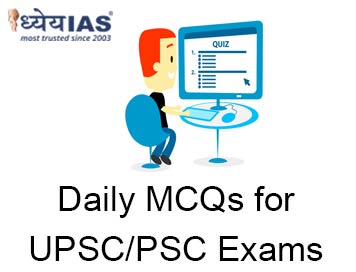Home > Daily-mcqs
Daily-mcqs 04 Nov 2025

Q1:
Consider the following statements about the Khabarovsk-class submarine: 1. It is part of Russia’s Project 09851 developed by the Rubin Design Bureau. 2. It is conventionally powered and designed mainly for anti-submarine warfare. 3. It serves as a carrier for the Poseidon nuclear-powered underwater drones. Which of the statements given above is/are correct?
A: 1 and 2 only
B: 1 and 3 only
C: 2 and 3 only
D: 1, 2, and 3
Answer: B
Explanation:
Statement 1 Correct: The Khabarovsk-class is indeed part of Project 09851, built by the Rubin Central Design Bureau of Marine Engineering.
Statement 2 Incorrect: It is nuclear-powered, not conventionally powered, and its main purpose is strategic deterrence via carrying Poseidon AUVs, not conventional anti-submarine warfare.
Statement 3 Correct: It can carry up to six Poseidon nuclear-powered underwater drones designed for strategic nuclear deterrence.
Q2:
Consider the following statements regarding India’s nuclear doctrine: 1. It is based on the principle of credible minimum deterrence. 2. Since 2024, it allows the first use of nuclear weapons in case of an imminent threat. 3. It includes a voluntary moratorium on nuclear testing since 1998. Which of the statements given above is/are correct?
A: 1 and 2 only
B: 2 only
C: 1 and 3 only
D: 1, 2, and 3
Answer: C
Explanation:
Statement 1 Correct: India’s nuclear doctrine is anchored in credible minimum deterrence, ensuring sufficient nuclear capability to deter adversaries without engaging in an arms race.
Statement 2 Incorrect: India follows a No First Use (NFU) policy, meaning nuclear weapons will only be used in retaliation to a nuclear attack.
Statement 3 Correct: After the 1998 Pokhran-II tests, India declared a voluntary moratorium on further nuclear testing, demonstrating restraint and responsibility.
Q3:
Which of the following treaties or agreements has India not signed or not ratified? 1. Comprehensive Nuclear-Test-Ban Treaty (CTBT) 2. Treaty on the Prohibition of Nuclear Weapons (TPNW) 3. Non-Proliferation Treaty (NPT) Select the correct answer using the code below:
A: 1 and 2 only
B: 1 and 3 only
C: 2 and 3 only
D: 1, 2, and 3
Answer: D
Explanation:
India has not yet signed any treaties.
India has not signed the CTBT, citing discriminatory provisions and the need to ensure the reliability of its deterrent.
India has also not joined the NPT, which divides the world into “nuclear weapon states” and “non-nuclear weapon states” as of 1967.
The Treaty on the Prohibition of Nuclear Weapons (TPNW), adopted in 2017, has also not been signed by India since it does not align with India’s deterrence-based security posture.
Q4:
With reference to the recently launched GSAT-7R satellite, consider the following statements: 1. It is India’s heaviest indigenous communication satellite developed by ISRO. 2. It was launched aboard the LVM3 rocket from Sriharikota. 3. It is primarily designed to enhance communication capabilities of the Indian Air Force. Which of the statements given above is/are correct?
A: 1 and 2 only
B: 2 only
C: 2 and 3 only
D: 1, 2, and 3
Answer: A
Explanation:
Statement 1 Correct: GSAT-7R (CMS-03) is India’s heaviest indigenous communication satellite, weighing around 4,410 kg.
Statement 2 Correct: It was successfully launched on 2 November 2025 aboard the LVM3-M5 (Launch Vehicle Mark-3) from Satish Dhawan Space Centre, Sriharikota.
Statement 3 Incorrect: The satellite is designed primarily for the Indian Navy, not the Air Force. It builds on the earlier GSAT-7 (Rukmini), which also served naval communication needs.
Q5:
With reference to the Nipah virus (NiV), consider the following statements: 1. It is a zoonotic virus with fruit bats of the Pteropus genus as its natural reservoir. 2. It can spread from human to human through close contact. 3. There is no vaccine is available for Nipah virus. Which of the statements given above is/are correct?
A: 1 and 2 only
B: 2 only
C: 2 and 3 only
D: 1, 2, and 3
Answer: D
Explanation:
Statement 1 Correct: Nipah virus is zoonotic, originating in fruit bats (genus Pteropus), also called flying foxes.
Statement 2 Correct: It can spread from animals to humans and between humans via close contact, contaminated surfaces, or respiratory droplets.
Statement 3 correct: There is no licensed vaccine or specific antiviral treatment for Nipah virus; care is primarily supportive.